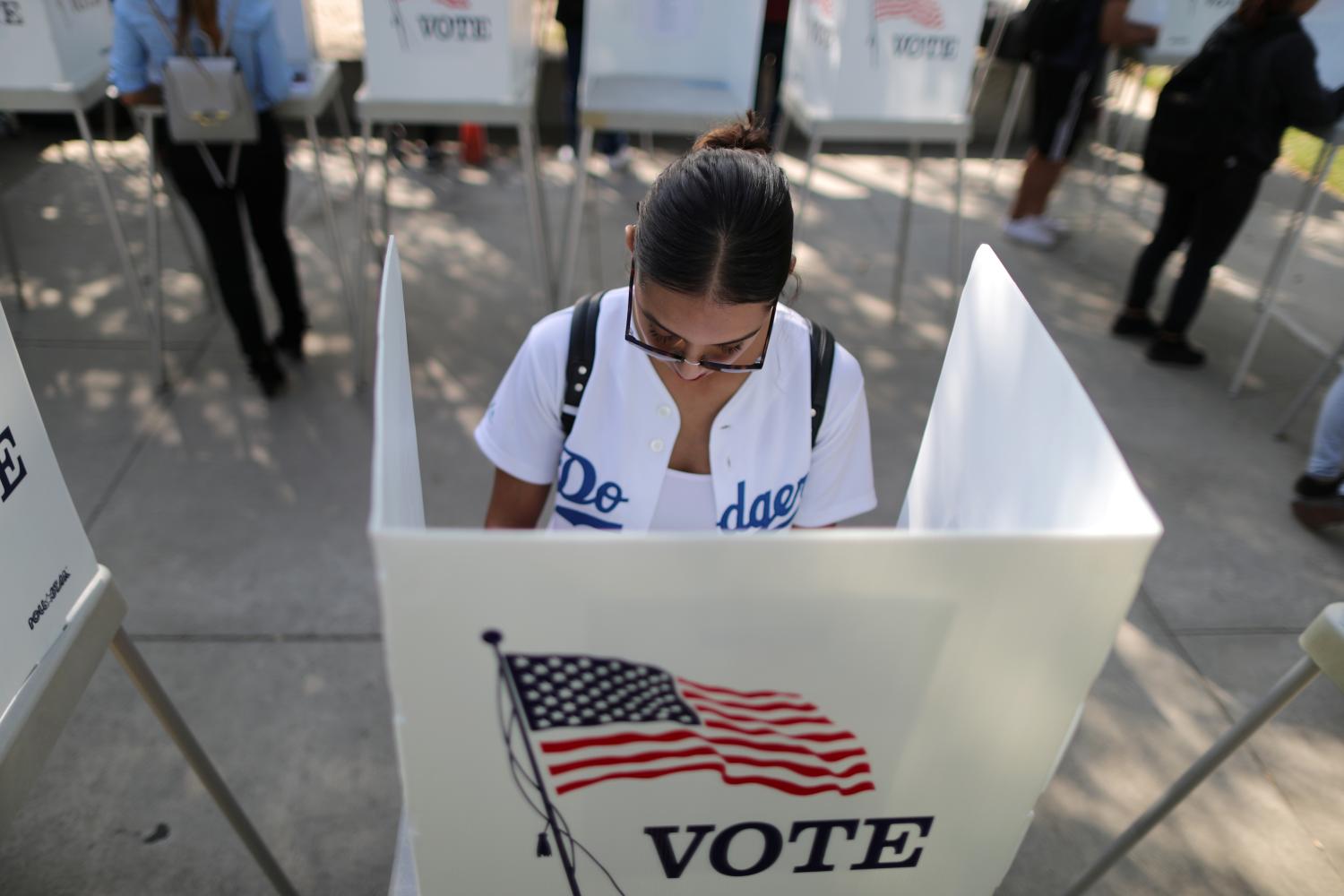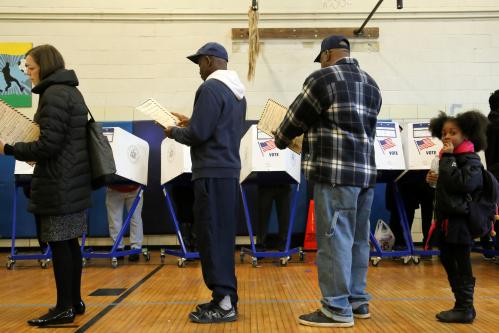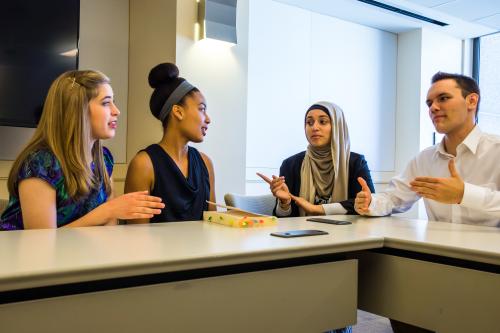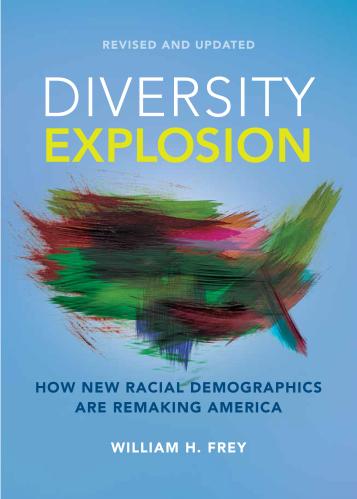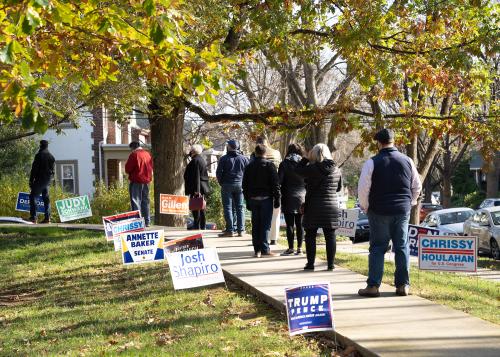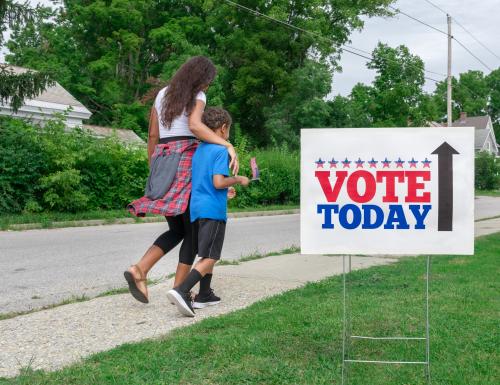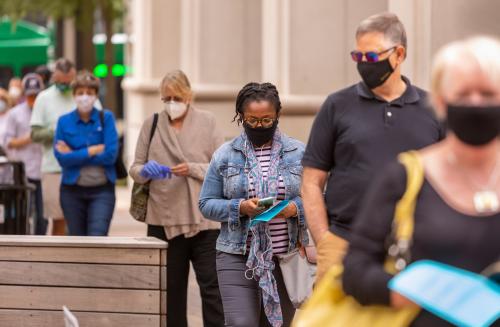Table 2 was updated on November 1 to correct Scenario 3’s turnout group.
The 2018 midterm election seems different than most. While President Trump is not on the ballot, many of his detractors and supporters are likely to vote as if he were. Chief among the former are racial minority groups, especially blacks and Hispanics concerned about his stances on racial equity and immigration. Detractors also include white women with college degrees who became energized after the confirmation of Justice Kavanaugh. Of course, the president’s strongest supporters, white men without a college degree, could also play an outsized role.
Will a surge in turnout among groups who oppose Trump bring Democrats a blue wave victory? It’s possible. After reviewing past turnout patterns in midterm elections, my analysis below provides national and selected state simulations for projected 2018 voting, based on different turnout scenarios.
Midterm election turnout and the voter population
Voter turnout rates (the share of citizens age 18 and older who vote) have long been lower for midterms than for presidential elections. There is also noticeable variation across demographic and social groups, shown in Figure 1, which displays average turnout rates for the past four midterm and presidential elections. (For individual year rates, download Table A.)

Overall, 45 percent of eligible voters turn out for midterm elections. Older people (61 percent 65 and older) are more likely to vote than younger people (23 percent age 18 to 29), whites (49 percent) are more likely to vote than racial minorities as a whole, and blacks (42 percent) are more likely to vote than Asians or Hispanics (30 percent). It is noteworthy that, among eligible white voters, both men and women with college degrees (63 to 65 percent) turn out at markedly higher rates than their counterparts without degrees (41 to 44 percent).
If historical patterns hold, some of the groups critical to Democrats’ chances will be overrepresented on Election Day, while others will be underrepresented (Figure 2). Under these assumptions, whites would make up 75.1 percent of voters, compared to their 67.7 percent share of eligible voters. In contrast, Hispanics would comprise just 8.4 percent of voters compared with 12.3 percent of those eligible to vote. So, while racial minorities will likely show up in smaller numbers on Election Day, whites—especially college graduate whites—will show up in larger numbers. Interestingly, because of their lower turnout rates, white males without college degrees would constitute a smaller share of voters than of eligible voters.

Of course, the above estimated voter profiles reflect average midterm turnout rates. Because those rates are well below those shown for presidential elections, there is a potential for a marked increase in any energized group’s turnout—at the national, state, or local level.
Simulations of the 2018 election: National voting
Past may not be prologue, however. The 2018 midterm elections seem likely to change turnout patterns among “energized” groups. One scenario assumes higher-than-normal turnout rates for each major racial minority group, and a second scenario adds increased turnout for white college graduate women, all groups assumed to support a Democratic candidate in the current political environment. A third scenario additionally assumes increased turnout for white men without college degrees, voters who are part of President Trump’s Republican base.
The simulations begin with race, education, and gender attributes in the United States as of 2018, shown in Figure 2. The “baseline” simulation assumes average midterm turnout rates for these groups, shown in Figure 1. It also assumes that these groups will follow their Democratic minus Republican (D-R) voting margins observed in the 2016 presidential election with the following alterations: increasing the D-R voting margins by +5 for each racial minority group to be more consistent with those shown in the 2012 election of President Obama; and increasing the margin by +10 for white college graduate women in keeping with recent polls showing rising Democratic support for this group.
Figure 3 shows that large Democratic margins hold for blacks, Hispanics, and Asians, while large Republican margins hold for white men and women without college educations. White college graduate women show a +17 Democratic advantage.

The results of the various national simulations are displayed in Table 1. The baseline in Figure 1 yields a national Democratic advantage of 1.2 percent (50.6 percent voting Democratic and 49.4 percent voting Republican). Thus if normal midterm turnout patterns were applied to today’s electorate, there would be a modest Democratic win. Scenario 1 increases turnout for each minority group by 25 percent, which pushes up the Democratic advantage to 4.9 percent. In addition to more minorities voting, scenario 2 increases white college graduate women’s turnout by 25 percent, and yields a Democratic advantage of 5.4 percent. Finally, scenario 3 adds a turnout increase of 25 percent for Republican-leaning white males without college degrees, which reduces but does not reverse the Democratic advantage. While each of these turnout increases are substantial, they still do not reach the turnout levels for these groups observed in average presidential election years.
These three scenarios indicate that boosts in turnout for each of these demographic groups can contribute to substantial changes in election results and combine to work in favor of the Democrats across the national vote total.
 Simulations of the 2018 election: Selected states
Simulations of the 2018 election: Selected states
Of course, the midterms aren’t equivalent to a presidential election; results at the state level are more relevant than national totals. Turnout surges may be especially consequential in states where particular demographic groups maintain an outsized presence—such as blacks in Georgia; white men without college degrees in Pennsylvania; or Hispanics in Florida, Nevada, and Texas. Each of these states has significant senatorial or gubernatorial contests that could also filter down to congressional district outcomes.
To assess the rising turnout influences on state elections of the same groups as above—minorities, white female college graduates, and white males without college degrees, I conducted similar simulations for these five states, each of which exhibit different demographic voter profiles (download Table B).
The results of these simulations are summarized in Table 2 with more detailed outcomes shown in Table C (download Table C). The baseline scenario for a state assumes that state’s 2016 presidential election voting preferences for each demographic group with the alterations discussed above. It also assumes average midterm turnout rates for each group in that state. This baseline scenario yields Republican vote advantages for all states except Nevada, which shows a small Democratic advantage of 0.6 percent. The Republican vote advantages are largest for Texas and Georgia at 6.6 percent and 4.6 percent, respectively, and more modest for Florida and Pennsylvania at 4.6 and 2.0 percent, respectively.

Despite the initial Republican advantages in the latter four states (each of which registered Trump victories in 2016), three of them shift to a Democratic vote advantage when minority turnout rises by 25 percent or when both minority and white college graduate female turnout rises by that amount. Especially noteworthy is the shift in Georgia to a 2.6 percent Democratic advantage when minority turnout is increased, given the energy associated with African American gubernatorial candidate Stacey Abrams. Pennsylvania’s shift to a Democratic advantage of 2.0 percent is more strongly associated with increased turnout of white college graduate women. In Florida, turnout-induced Democratic vote advantages were much more modest—less than 1.0 percent—and most closely associated with minority turnout.
In Texas, a state where minorities comprise half the electorate, Republicans maintain an advantage even assuming a 25 percent increase in minority turnout. This can be explained by strong support for Republicans among whites in that state, even among white college graduate women. Still, a minority surge would reduce the Lone Star State’s Republican advantage from 6.6 percent to 1.5 percent with all else staying the same.
In Florida, Georgia, Pennsylvania, and Texas, a 25 percent increase in turnout among white men without a college degree would counter the effects of other turnout surges to yield a Republican vote advantage, though a smaller one than assumed in the baseline scenario. In both Georgia and Pennsylvania, that Republican advantage is exceptionally small.
Nevada represents the exception among the states covered. Here the rising turnout of minorities and white college graduate women would increase its Democratic advantage to 3.5 percent. Even white men without a college degree showing up to vote would not take away the Democratic advantage in the Silver State.
The simulations presented here show that midterm voter turnout surges can make a huge difference both nationally and at the state level. Nationally, high turnout of Democratic-leaning groups would work to counter a similar surge among President Trump’s base. In historically Republican-voting states like Georgia and Texas with large black or Hispanic populations, increasing minority turnout by 25 percent would, all else being equal, swerve them to a Democratic advantage or at least make the races competitive. In a northern, whiter state like Pennsylvania, greater turnout among its heavily suburban white college graduate female bloc could move the needle toward the Democrats, assuming a counter surge turnout of white working class men did not take place. Even if it did, the state would be competitive. These three groups—minorities, white college graduate women, and white men without a college degree—are the ones to watch in this highly partisan, energized midterm election. Their turnout nationally and at the state level could change the direction of American politics over the next few years.

